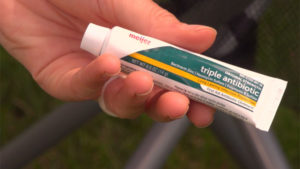rving with pets
Canine Paw Protection with Dr. Fitz on 'Paws on Board'
Welcome to “Rollin’ On TV’s” “Paws on Board.” I’m Dr. Fitz, and this is Bruno. Today we’re gonna be addressing canine paw protection, specifically related to hot surfaces. The main surfaces that we worry about for heat-related injury are asphalt, cement or concrete, and even sand. When you plan to take your dog for a walk downtown or to the beach, you should ensure that the surface is safe enough for their paws. You can ensure that the surface is safe for your dog to walk on by placing your hand
directly on the ground. If you can’t keep your hand in place for at least ten seconds, the surface is too hot for your dog to walk on safely for any length of time. Remember, you’re wearing shoes, but your dog is usually barefoot.
 Some ways that owners have protected their dog’s feet include putting special boots or socks on their dog. So boots like these that have extra protection on the bottom can be helpful. Many dogs don’t like these boots at first and usually avoid walking while they’re on. But once your dog is used to them, they can keep your dog’s paw pads safe from the hot pavement or sand. Some owners even use them on hikes or in the campground to keep their dog’s feet safe from twigs and rocks that may damage the pads. Make sure that you try out the boots prior to traveling, as there are different sizes and styles. If you’ve ever had a blister when wearing the wrong hiking boots, you can imagine that your dog may feel the same if the boots don’t fit. If your dog won’t wear protective boots, try to walk them on surfaces that don’t get very hot, such as grass or dirt. Also, consider walking them in the morning or the evening time when temperatures have cooled.
Some ways that owners have protected their dog’s feet include putting special boots or socks on their dog. So boots like these that have extra protection on the bottom can be helpful. Many dogs don’t like these boots at first and usually avoid walking while they’re on. But once your dog is used to them, they can keep your dog’s paw pads safe from the hot pavement or sand. Some owners even use them on hikes or in the campground to keep their dog’s feet safe from twigs and rocks that may damage the pads. Make sure that you try out the boots prior to traveling, as there are different sizes and styles. If you’ve ever had a blister when wearing the wrong hiking boots, you can imagine that your dog may feel the same if the boots don’t fit. If your dog won’t wear protective boots, try to walk them on surfaces that don’t get very hot, such as grass or dirt. Also, consider walking them in the morning or the evening time when temperatures have cooled.
 What if, in spite of your precautions, your pet burns its paws? Burns of the feet can be very painful, so keep this in mind even if the burn is small. In season 1 of “Paws On Board,” I covered some items to have in a pet first aid kit. It can be important to have triple antibiotic ointment and bandage material with you so you can quickly treat and cover a burn. Small burns can heal on their own pretty quickly, but more extensive burns involving multiple paw pads may need further treatment and pain medication. If this is the case, gently bandage the areas and take your pet to a veterinarian for treatment.
What if, in spite of your precautions, your pet burns its paws? Burns of the feet can be very painful, so keep this in mind even if the burn is small. In season 1 of “Paws On Board,” I covered some items to have in a pet first aid kit. It can be important to have triple antibiotic ointment and bandage material with you so you can quickly treat and cover a burn. Small burns can heal on their own pretty quickly, but more extensive burns involving multiple paw pads may need further treatment and pain medication. If this is the case, gently bandage the areas and take your pet to a veterinarian for treatment.
For more information about traveling safely with your pets, visit rollinontv.com. Tune in next time for more pet health information. I ‘m Dr. Fitz, and this is Bruno. Thanks for watching “Paws on Board”.


